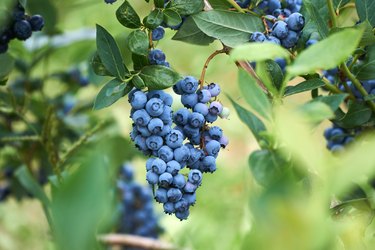
Blueberries are a fun, sweet and tart little snack that's so much better when freshly picked. Luckily, growing blueberries in Alabama is a fairly easy project. Blueberries grow especially well in warmer southern climates. They easily take to new ground and don't require very much maintenance to grow. In fact, some varieties of blueberries are native to southern states, like Alabama, making it the perfect environment to grow a few bushes in your backyard.
Growing Blueberries in Alabama
Video of the Day
It's best to plant blueberry bushes in Alabama during one of two periods: early spring or late fall. Most local gardeners prefer to plant during late fall, however. This is when the bushes are mostly dormant, giving them time to establish themselves in the ground and absorb nutrients before late spring, when they will blossom and produce fruit.
Video of the Day
This is especially true in warmer climates, like Alabama, where regional varieties are accustomed to the mild winters. In these cases, aim to plant varietals any time from November through December for best results. Typically, blueberry bushes should be pruned when they are planted to help stimulate fresh growth when spring rolls around.
Blueberries need a sunny spot with good drainage that's protected against storms and harsh winds. They do best in well-aerated soil rich with organic matter and in an acidic soil with a low pH between 4.5 and 5.5. If your soil naturally has a more neutral pH, you can use ground rock sulfur or urea-based fertilizer products to lower the pH to a more ideal level. If you aren't sure of the pH of your soil, it's best to send a sample to a local testing agency so it can tell you exactly what your plants need. Blueberry plants have notably shallow roots, so clear the area of planting and keep an eye out so that weeds don't encroach into the blueberry area.
Best Blueberry Bushes for Alabama
Keep in mind that different varieties of blueberry bush will produce berries at differing times, which can provide you with a supply of blueberries lasting for months. Check the recommended planting time for each type you have to make sure you can take advantage of this extended season.
While the most commonly planted blueberries are a variety called highbush, the variety called rabbiteye is native to Alabama and has evolved to thrive in the warmer USDA plant hardiness zones of 7 to 9. These are the easiest blueberries to grow in Alabama. They're generally resistant to pests, tolerant to drought conditions, less susceptible to certain kinds of root rot and highly productive.
Keep in mind, however, that rabbiteye blueberries require cross-pollination between different varieties in order to produce fruit, so planting a few types of rabbiteye blueberry bushes in a well-spaced cluster should guarantee you a yield of delicious berries lasting for months.
Additional Blueberry Types
Some other popular varieties include the 'Powderblue,' 'Woodard' and 'Brightwell.' 'Brightwell' is an early season variety, whereas 'Powderblue' will produce fruit mid to late season. With properly chosen varietals, the harvest season for rabbiteye blueberries can last from May all the way to July.
Southern highbush varieties have been bred from the more northern highbush plants to thrive in warm climates, like Alabama. The southern highbush varieties can be more difficult to grow than the native rabbiteye, but they are the earliest blueberries to ripen and will provide additional variety in the garden.
Blueberry bush varietals like 'Emerald,' 'Windsor' and 'Springhigh' are recommended. 'Emerald' is known for its high yield, while 'Windsor' normally produces very large berries, and 'Springhigh' is considered one of the toughest versions of southern highbush. Southern highbush varieties will do best in the most southern areas of Alabama, where the risk of late frosts is minimal.